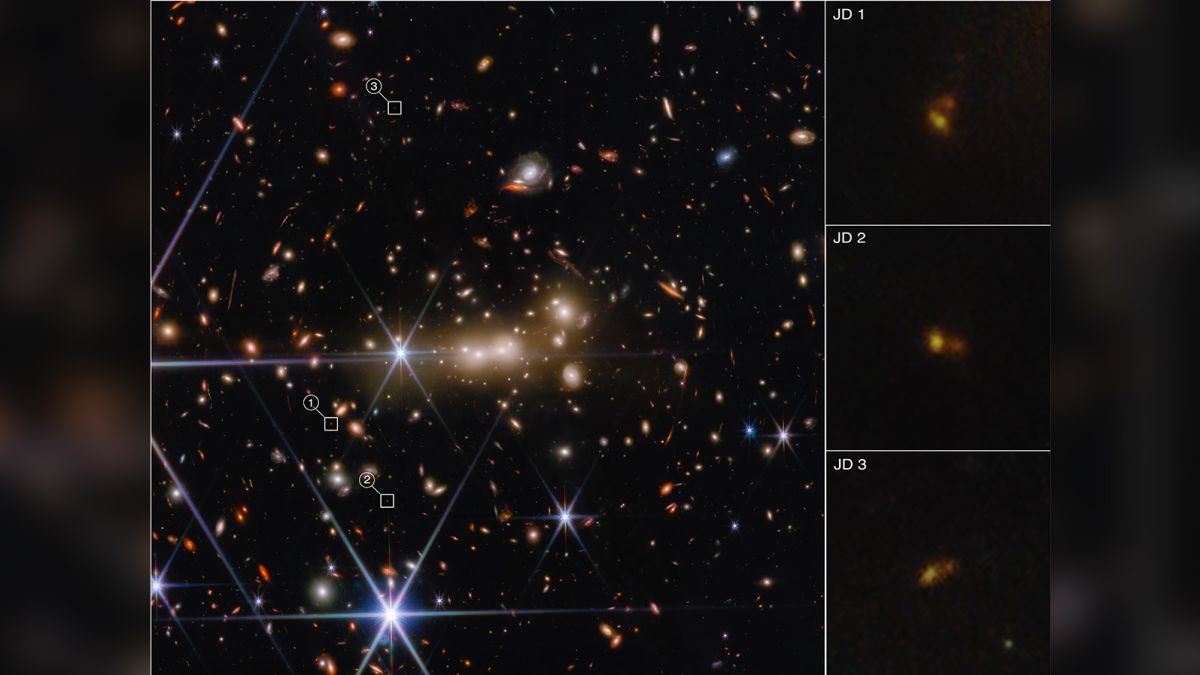(CNN) – The James Webb Space Telescope offered astronomers a glimpse into the universe’s earliest moments in a new image shared on Wednesday.
The powerful space observatory is able to detect the incredibly faint light of distant galaxies when they shine in infrared light, a wavelength invisible to the human eye. Webb is an important tool astronomers can use to better understand how galaxies formed and evolved in the early universe.
The telescope captured an image of a group of galaxies called MACS0647, as well as the distant galaxy MACS0647-JD. The cluster appears as a dazzling collection of galaxies that appear to sparkle like gems against the dark background of space.

The MACS0647 galaxy cluster bends and magnifies the light of the outermost galaxy, MACS0647-JD. credit: NASA
The outermost galaxy appears due to some kind of observing phenomenon that goes back to the mass. This phenomenon, called gravitational lensing, occurs when foreground galaxies act like a magnifying lens for distant objects behind them.
Small boxes were used to locate the galaxy MACS0647-JD, with more detailed images aligned along the right side of the image. The cluster essentially makes a triple lens for the galaxy, magnifying it and making it appear in three different places in the image. Each box on the right shows different details of the galaxy.
Astronomer Dan Koo discovered the galaxy MACS0647-JD 10 years ago using the Hubble Space Telescope. A new Web image of the galaxy has revealed a surprise: It has two distinct features.
“With Hubble, it was just a pale red dot. We can tell that it was really small, just a small galaxy in the first 400 million years of the universe,” said Koo, an astronomer at the Space Agency’s Space Telescope Science Institute. Consortium and Consortium of Universities for Research in Astronomy, in a Release from NASA.
“Now we look at Webb, and we can distinguish between two objects! We are actively debating whether two galaxies or two groups of stars are within a single galaxy. We don’t know, but these are the questions that Webb designed.”
The two colors differ from the two objects, with one being more blue and the other more red. The colors indicate different gases. While the blue body indicates young star formation, the red body is covered in dust and is older. Astronomers believe that the two objects in the galaxy image may suggest a merger of two galaxies.
“It’s really exciting to see two structures in such a small system,” Tiger Yu-Yang Hsiao, a doctoral student at Johns Hopkins University, said in a statement. “We could witness galaxies merge in the very early universe. If it’s the farthest merger, I’d be really happy!”
Research team wrote Article – Commodity about the discovery of a possible merger, but, like many of Webb’s first observations since it began its science operations in July, the results have not yet undergone a peer-reviewed process. The team also plans to conduct a more detailed study of MACS0647-JD in January.
Each Webb’s observation reveals the hidden and hitherto unseen aspects of the universe, as the telescope has the ability to look in dim infrared light through thick interstellar dust. Astronomers are excited about the telescope’s potential for discoveries because the observatory only began its twenty-year mission a few months ago.
“Until now, we haven’t been able to study galaxies in the early universe in great detail. Before Webb we only had dozens of them,” says Rebecca Larson, a National Science Foundation fellow and a doctoral student at the University of Texas. In Austin, it’s a statement. “Studying them can help us understand how they evolved into a galaxy like the one we live in today. And also, how the universe has evolved over time.”

“Proud web fanatic. Subtly charming twitter geek. Reader. Internet trailblazer. Music buff.”

:quality(85)/cloudfront-us-east-1.images.arcpublishing.com/infobae/TEQF6EONZRFGLLLDIDD4L2O4EE.jpg)

:quality(75)/cloudfront-us-east-1.images.arcpublishing.com/elcomercio/XU32LRAEZFDDPNVHLFU3CKVBYY.jpg)



More Stories
How to create 3D videos with my iPhone, it will be very useful even for your business
NASA discovers an anomaly in the Earth’s magnetic field that could have serious consequences for humans
Can the Earth be divided into two parts?